Don't know what to choose between BigCommerce vs Magento? I understand that choosing the right eCommerce platform has never been an easy task. Therefore, I commit to helping you overcome that difficulty with my experience and knowledge.
If you are considering between BigCommerce vs Magento, welcome! In this article, I will explain all the differences of these two platforms based on my observation and practical understanding. My comparison consists of 10 factors, including:
- Pricing
- Ease of use
- Themes and customization
- Apps & extensions
- Payment options & fees
- SEO features
- Scalability
- Security
- Support
Without any delay, let's start!
BigCommerce vs Magento – A Pros & Cons Analysis
Before diving into the detailed comparison of BigCommerce vs Magento, let's see all their pros & cons first. I believe this information can contribute to your final decision later on.
BigCommerce pros & cons
Pros | Cons |
✅ No transaction fees on any plan ✅ Powerful out-of-the-box features ✅ Strong scability ✅ Mobile-friendly storefront ✅ Robust built-in B2B functions ✅ Around-the-clock customer support ✅ Completely secure with PCI compliant | ❌ Steep learning curve for beginners ❌ Annual sales limits on Standard plans ❌ Limited design flexibility ❌ Limited control over data |
Magento pros & cons
Pros | Cons |
✅ Complete control over data ✅ High level of customizability ✅ Strong SEO capability ✅ Wide selection of third-party extensions ✅ Large and active community for support | ❌Requires high technical expertise to deal with a steep learning ❌Involves regular maintenance and update ❌Is not beginner-friendly |
BigCommerce vs Magento – Who Is Best for You?
Frankly speaking, I don't think there's a definite answer to the question, “What is better, BigCommerce or Magento.” Each platform has its own strengths and weaknesses. Therefore, they can cater to different needs and expertise levels.
Based on my experience and observation, here is my personal take on BigCommerce vs Magento.
BigCommerce shines for businesses seeking a user-friendly yet powerful solution. Its comprehensive set of built-in features, paired with intuitive design and 24/7 support, makes it ideal for growing companies without extensive technical resources. Businesses prioritizing ease of use, faster setup, no transaction fee, and predictable monthly costs will find BigCommerce a suitable choice.
Magento, on the other hand, caters to businesses with greater technical capabilities and a desire for ultimate control. Its open-source nature allows for limitless customization and scalability, making it a suitable platform for large enterprises and businesses with highly specific or complex needs. However, this flexibility comes at the cost of significant technical expertise and potentially higher development costs. Companies who prioritize complete control over their online stores, including data, monthly expenses, and all other elements, will find Magento a fitting solution.
#1. Pricing
Pricing is an essential factor when choosing an eCommerce platform. You have to calculate the budget before deciding which plan is suitable for you. Follow us to find out the packages that BigCommerce vs Magento provides.
In general, all BigCommerce packages offer essential features and functions that help you start your online business easily and effectively.
Some of the common features you can access on any pricing model include an incredible single-page checkout, unlimited products, a responsive website, free transaction fees, etc. Obviously, there are some outstanding ones that are only available in more expensive plans.
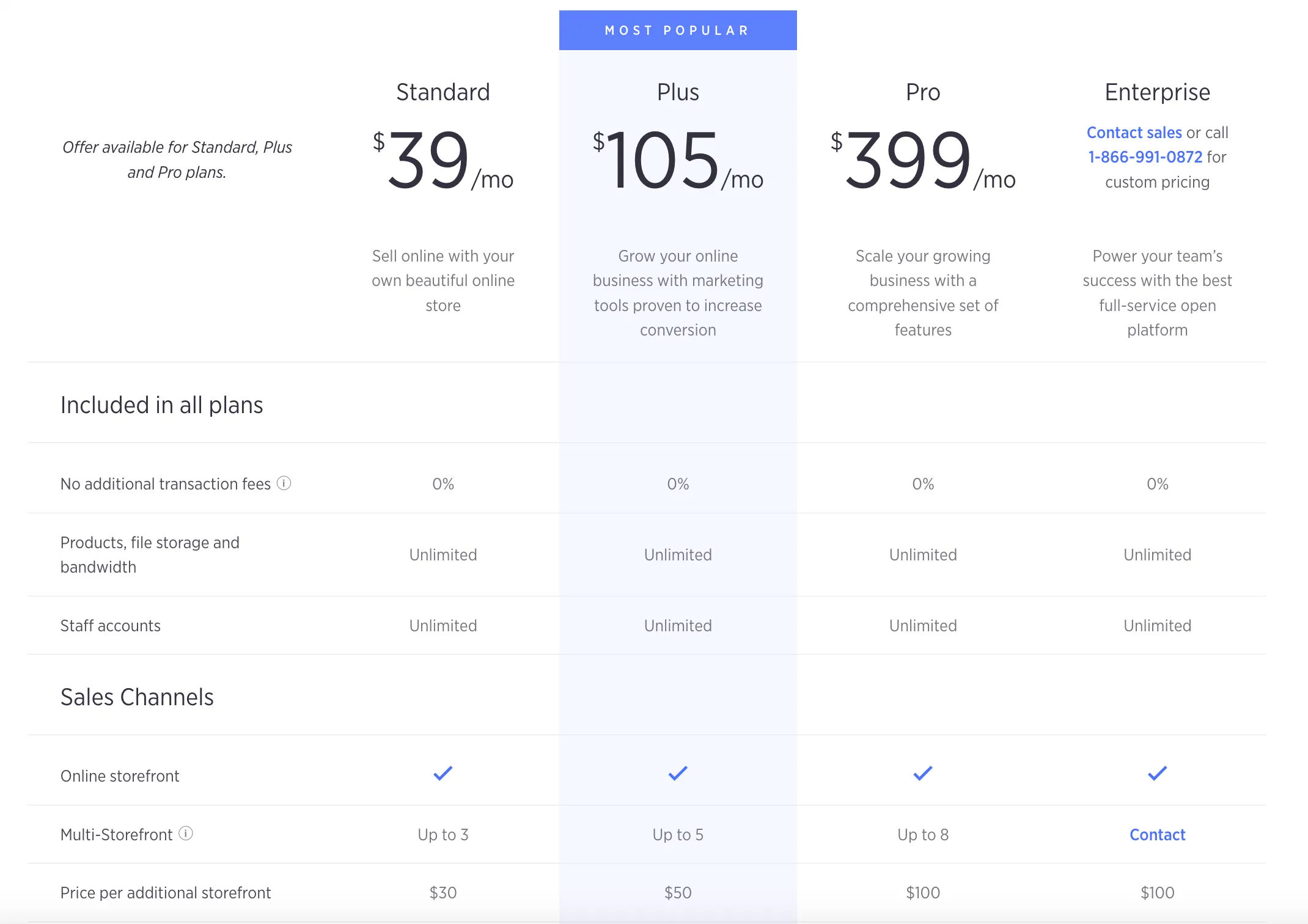
So, which BigCommerce plan is the best option for you?
- The Standard Plan is the cheapest at $39 per month. This plan has all the necessary features for you to start your online business. With this plan, online sales per year are limited, the revenue per year is only permitted up to $50,000. Therefore, it’s suitable for newbies or small businesses.
- Plus Plan – the most popular plan with $105. The BigCommerce Plus Plan has all the Standard Plan features. Other additions include customer groups and segmentation, a persistent cart, and an abandoned cart saver. The revenue per year is up to $180,000, store owners who have medium-scale businesses should come with this plan.
- The Pro Plan will cost you $399 per month and provides even more scalable features than the Plus Plan. Some of the additional features are Google customer reviews, faceted search (product filtering), and custom SSL. Pro Plan seems like for businesses scaling up or larger business. Still, if your revenue surpasses $400,000 per year, you have to pay additional fees (+$150/mo for each additional $200,000 in online sales).
- The Enterprise Plan is the most advanced plan. It has custom pricing, which depends on customers’ online sales. Not only does it cover everything included in the other plans, but it also offers some extra powers. Moreover, you will receive priority support from the experts if you have any troubles. So the Enterprise Plan should work well with companies that are moving very fast.
Now, let's move on with our BigCommerce vs Magento comparison on pricing with Magento. At present, Magento provides 3 editions, including Magento Open Source (previously known as Magento Community), Magento Commerce Edition (previously known as Magento Enterprise), and Adobe Commerce Cloud (previously Magento Commerce Cloud or Magento Enterprise Cloud Edition).
Let’s compare the cost that you have to pay for each one by taking a look at the table below!
| Revenue per year (USD) | Magento Commerce Edition (self-host) | Magento Commerce Cloud |
| 0 – <1 M | $22,000 | $40,000 |
| 1 – <5 M | $32,000 | $55,000 |
| 5 – <10 M | $49,000 | $80,000 |
| 10 – <25 M | $75,000 | $120,000 |
| 25 – <50 M | $125,000 | $190,000 |
The table shows the license fee of Magento Commerce and the cost of Magento Commerce Cloud (including license and hosting fee) per year. The higher the revenue you receive, the more you have to pay.
With Magento Open Source Edition, you don’t have to pay a license fee as in Magento Commerce and Magento Commerce Cloud. But both Magento Commerce Edition and Magento Open Source Edition require a hosting fee that ranges from $4 to $1000. With the former, you will unlock more features than the latter.
Besides that, while running your online store on Magento, you may need the help of web agencies or developers because using this platform is quite complex. On average, a quality Magento developer will cost between $65 to $150 per hour. So, that will cost you quite a lot of money if you do not have technical skills or an in-house development team to execute the changes you want.
The Verdict:
In terms of BigCommerce vs Magento on pricing, I think Magento has a slight edge over BigCommerce. This platform gives you complete control over your monthly expenses, so it would be easier to balance your budget and avoid overspending.
#2. Ease of Use
As a store owner, you always want to spend more time focusing on your customers, products, and brand, you don’t want to take much time on building, customizing, and editing a website. So, ease of use is a crucial element when it comes to choosing a platform. Let’s find out how easy it is to use BigCommerce vs Magento.
You can easily set up your store with detailed instructions on the dashboard. There are 8 key things you need to establish before your store can go live, including store profile, currencies, payments, store settings, shipping, tax, point of sale, and accounting.
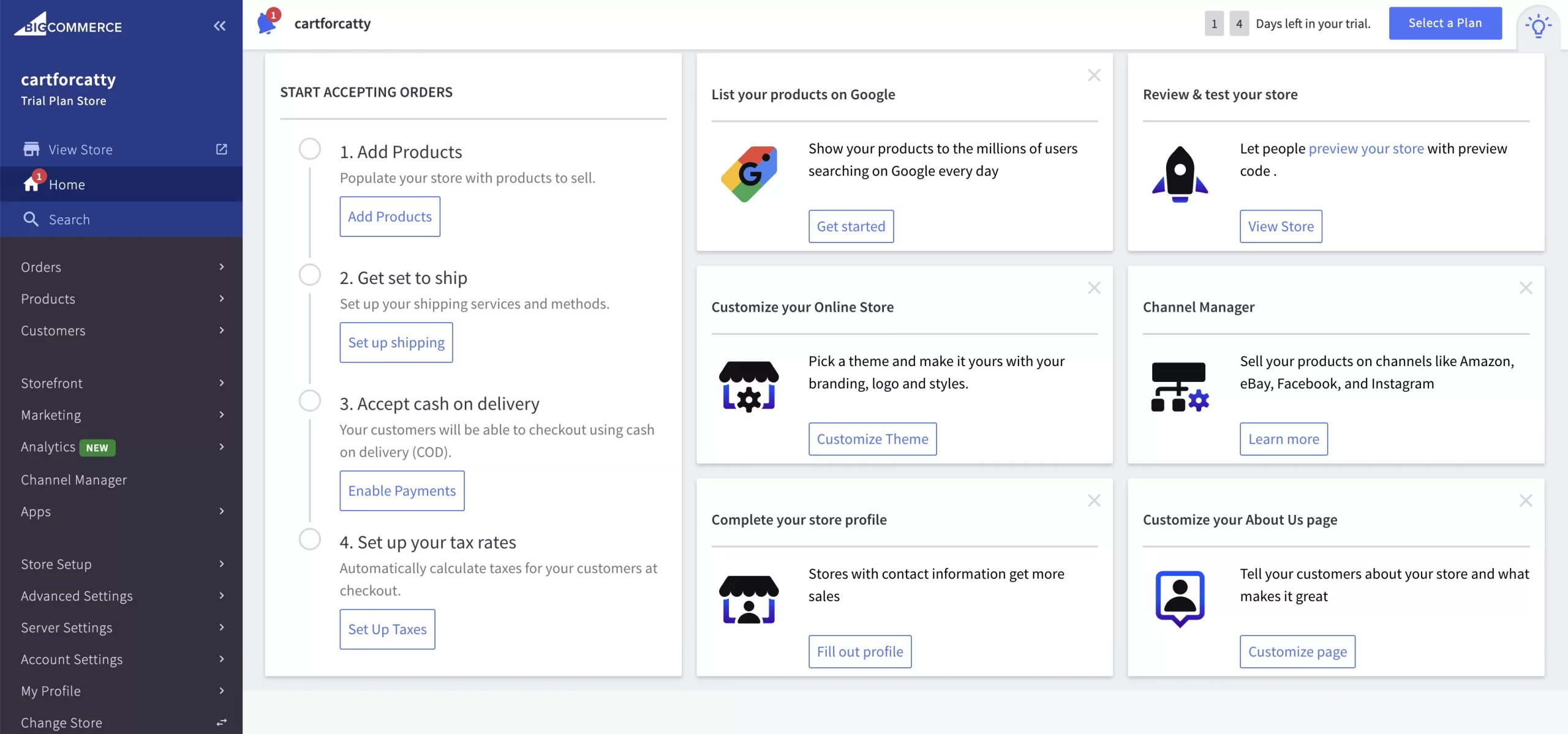
BigCommerce allows easy navigation on its interface, everything is quite smooth. However, this platform uses various tech terms, which is not easy to handle for non-technical people. If you are not a techie, you may need help from Google a lot to understand all the terminologies every time performing basic tasks such as adding a product.
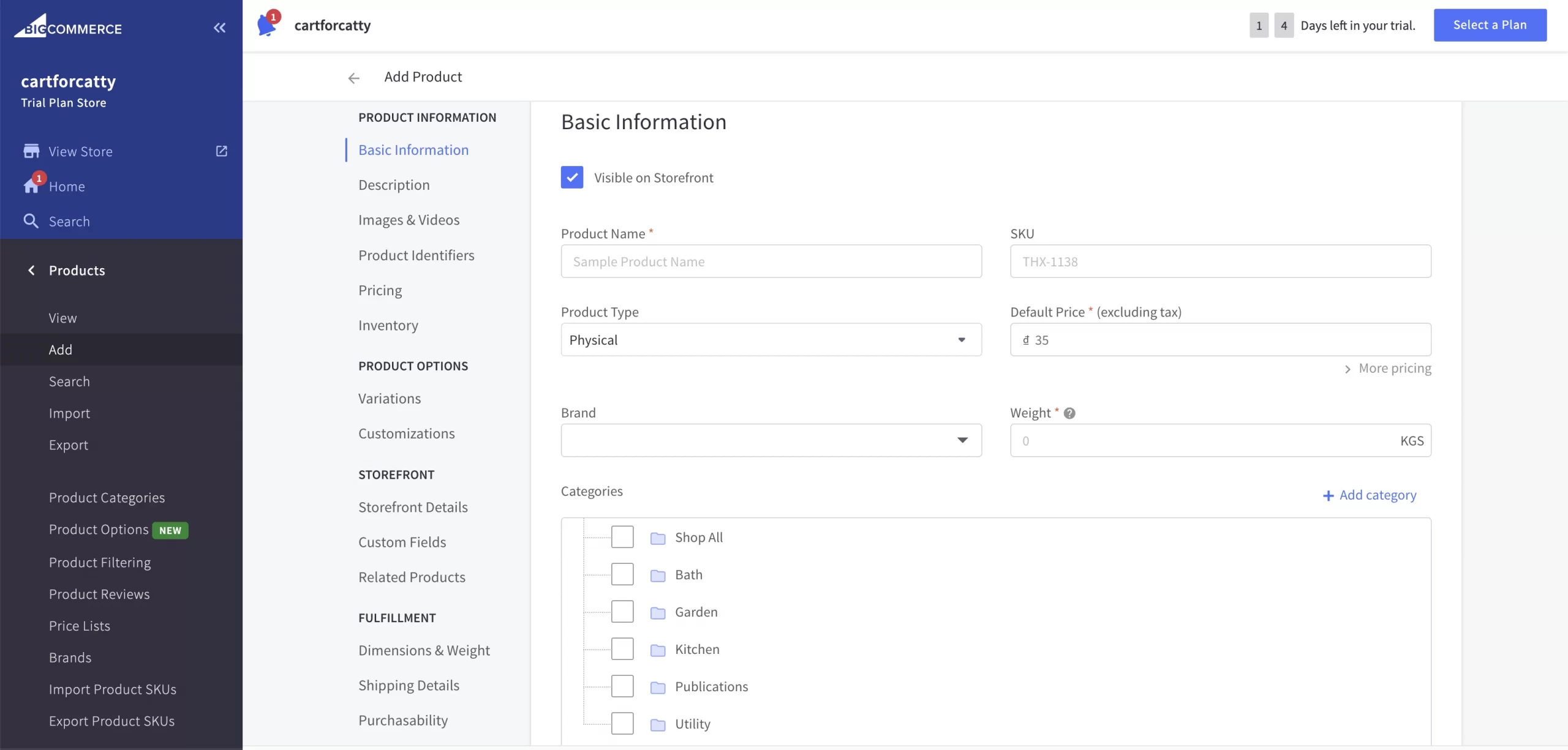
Besides, there is one drawback of the BigCommerce design interface. When you’re creating your store, it’s split between two areas. One is where you add products and manage your backend, while the other is where you edit your storefront. This can be confusing to navigate.
You can create a BigCommerce account to set up a BigCommerce website.
Setting up a new Magento store is not simple since there are many steps to take, including downloading Magento, setting up FTP, transferring the Magento archive to your hosted system, etc.
Moreover, you have to find ways to integrate extensions and customize themes yourself. Hence, you would need help from experts or developers to finish the task. However, the Magento interface is well-designed and thought-out if comparing its latest version, Magento 2, with the previous one.
Although it also uses complicated terminology on each page like BigCommerce, Magento 2 has a highly improved admin interface compared to Magento 1, allowing non-technical users to accomplish more without having to rely on their developers. Everything is consolidated on the navigational menu such as customers, products, promotions, sales, and reports.
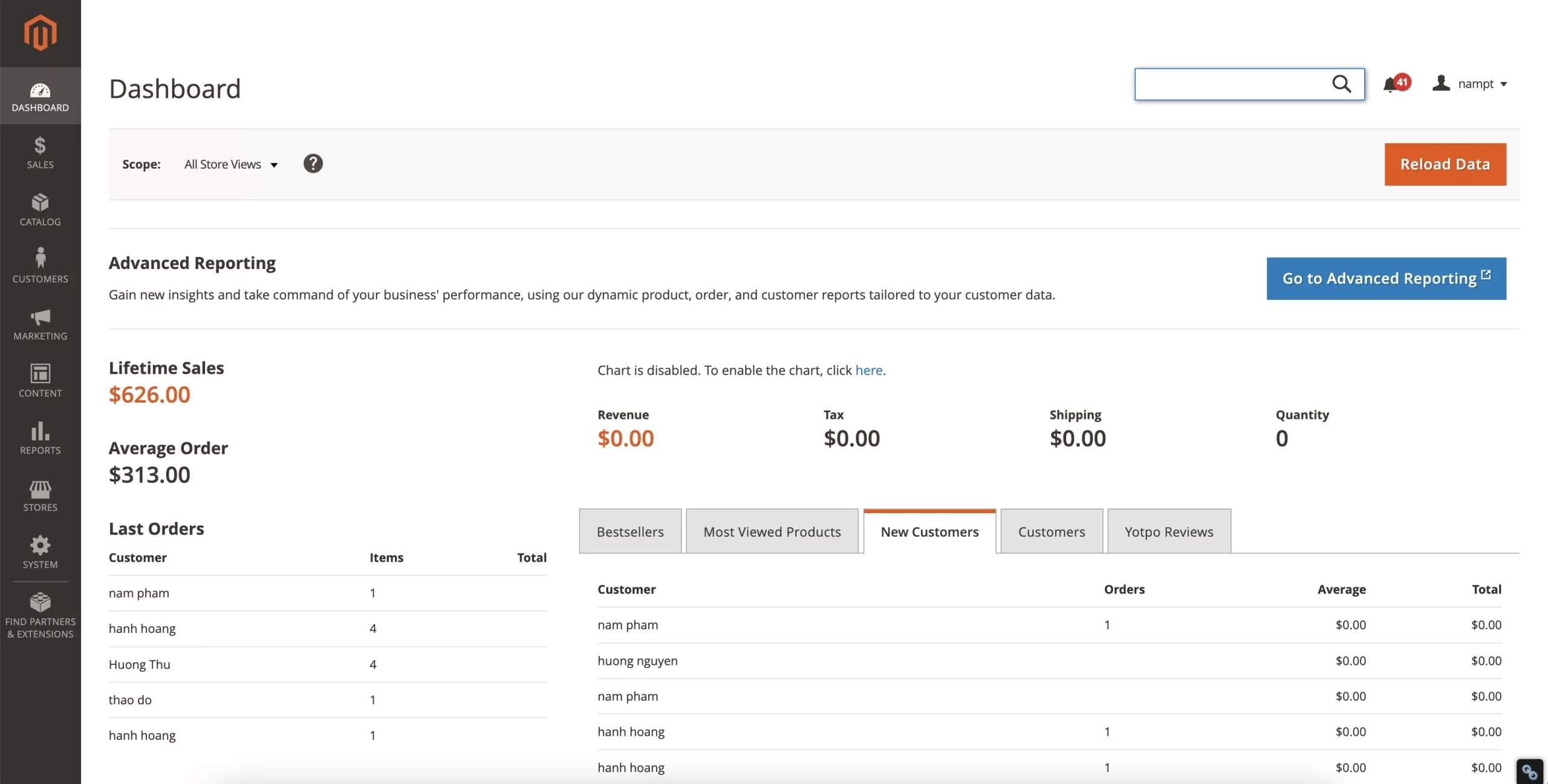
The Verdict:In summary, BigCommerce is easier to use than Magento. The setup process is quick and easy, and the instructions are clear. Furthermore, unlike Magento, you don’t need to know technical skills to customize your website because almost all the functions you need can be found on the BigCommerce dashboard.
#3. Themes & Templates
One of the most important things that merchants care about is the look of their platform. That will be the first impression shoppers have on the brands. So, follow me to find out the difference between theme and level of interface customization between BigCommerce vs Magento.
Currently, BigCommerce is providing 12 free themes and 200+ paid options, which cost from $150 to $399 each. All of these themes are mobile responsive and easy to customize with the help of Stencil – BigCommerce front-end development framework.

If you're wondering which BigCommerce templates may suit your store best, worry not! We've compiled a list of 8 best BigCommerce templates to solve your concern.
On the other hand, Magento offers 5 theme options in total, both free and paid. With Magento, you can even create your theme from scratch, but this requires you to have deep coding knowledge, or you can hire developers to do it for you.
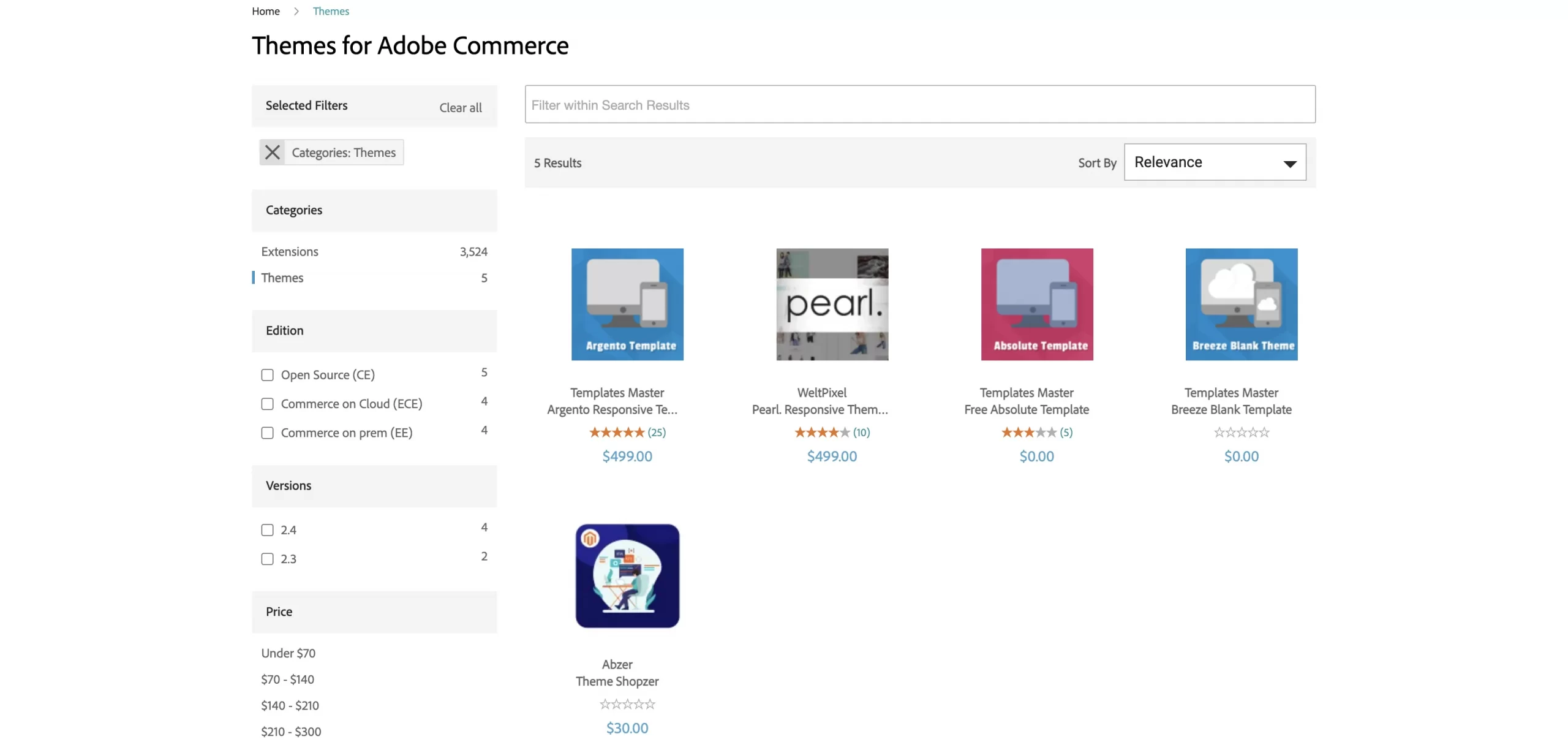
The Verdict:Once again, when it comes to themes, I must choose Magento as the winner between BigCommerce vs Magento. This platform offers much more design flexibility than BigCommerce, letting you customize your storefront any way you want as long as you have enough coding experience to pull it off.
#4. Apps & Extensions
Now, let's talk about apps & extensions of BigCommerce vs Magento.
As a hosted platform, BigCommerce provides strong built-in features that help your online store perform better. Some of the outstanding ones are:
- Abandoned cart reminders: This feature allows users to create and send out automated emails to any website visitors who went through the sales funnel and left without making a purchase.
- Analytic tools and reporting: With this feature, you can manage your site’s performance and assess campaigns.
BigCommerce also provides a wide range of apps for you to expand the functions of your store. At present, it supports over 600 BigCommerce apps belonging to different categories, such as Marketing, Analytics & Reporting, Payment & Security and Accounting, etc.
Like BigCommerce, Magento offers various and powerful built-in features such as Integrated checkout, payment, and shipping; mobile-optimized shopping; catalog management; instant purchase, and so on.
And of course, you can also buy third-party extensions on Magento Marketplace, which is now providing 4000+ extensions in all categories. You can refer to some highlight extensions of Magento here.
The Verdict:
In a nutshell, both BigCommerce vs Magento offer many robust integrated functions and support a wide range of extensions on their marketplaces. However, Magento is the winner in terms of extension quantity.
#5. Payment Options & Fees
BigCommerce offers over 65 integrated payment gateways to its users. Some of the big bosses are PayPal, Stripe, Square, Apple Pay, etc. All BigCommerce plans require no transaction fees. You just need to pay credit card rates. The higher the plan you choose, the less you have to pay for credit card rates.
Take a look at the below table, which shows credit card rates on each pricing plan of BigCommerce.
| Standard | Plus | Pro | Enterprise |
| 2.59% + $0.49
per transaction |
2.35% + $0.49
per transaction |
2.05% + $0.49
per transaction |
2.05% + $0.49¢ or lower
per transaction |
On the other hand, it seems like Magento offers more payment options than BigCommerce. Currently, there are more than 600 apps in the Magento Marketplace for you to choose from. Therefore, it may take you some time to select and integrate. However, some apps provide gateways that support other countries and languages, which is ideal for international businesses.
The Verdict:
#6. SEO Features
When running an online business, optimizing SEO is essential. On both platforms, you can edit the page title and meta description, add alt text to images, and customize URLs. However, let’s go further to see the differences between BigCommerce vs Magento in terms of SEO and marketing tools.
With that being said, if you are still unsure of the SEO implications of different eCommerce platforms, you can always hire an SEO consultant who understands the implications. They will be able to help you choose the best setup.
BigCommerce has some built-in SEO features like:
- Unique URLs: Ensuring that every unique page has only one URL, so you don't get punished for duplicate content.
- Micro-data: BigCommerce has integrated micro-data (rich snippets) into your product pages to enhance your search result listings with information like ratings, pricing, brand, and stock levels.
- 301 redirects and URL rewrites: When you rename a product, it will automatically generate a new URL, and the old URL will be redirected to the new URL. This helps search engines understand when you've made changes or moved pages on your site without manual effort.
- CDN (Content Delivery Network): This feature is always working in the background to ensure your site loads quickly for both shoppers and search engines. The fast site speed will boost the website’s search rankings.
In addition, you can go through 600 apps for BigCommerce to add SEO apps if you want. You can refer to these two trending SEO apps, such as Shogun Page Builder and FavSEO.
Meanwhile, Magento doesn’t offer as many built-in SEO features as BigCommerce, so you need to integrate SEO apps into a Magento store.
Some of the apps that help expand Magento SEO functionality are:
- SEO Toolkit, some of the top-notch features this extension offers you are:
- Generate relevant meta tags with ease;
- Help you build robust sitemaps;
- Quickly import and export product tags;
- Make your product reviews SEO-friendly;
- Show rich snippets in search results;
- Create and automate meta tag templates.
- Advanced SEO Suite, some of the highlight features of this extension are:
- Take care of SEO settings for pages, layered navigation, and categories;
- Take advanced rich snippets;
- Generate Meta-tags with templates;
- Generate advanced Sitemap for Google;
- Manage all redirects quickly and easily;
- Get an SEO analysis of every page;
- Increase your website visibility on search engines and grow your CTR.
The Verdict:When it comes to SEO features, I must say BigCommerce is slightly better than its counterpart in BigCommerce vs Magento comparison. BigCommerce provides a user-friendly approach to SEO, packing powerful features into the dashboard with no requirements to install third-party extension.
#7. Scalability
When choosing eCommerce platforms, you need to take into account the future business scale that you are orienting to.
BigCommerce has some outstanding features to plan for your store's future growth:
- Open API: BigCommerce enables developers to create an entirely customized user experience for their customers with an open API.
- 100% uptime: This is a very important factor as your business grows and traffic increases. BigCommerce will ensure that your store will maintain the normal loading speed during peak periods.
- Bringing order to the back-end with an ERP: An integrated ERP allows employees in different departments( eg: accounting, logistics, and sales, etc) to rely on the same information and data source
- Product information management (PIM): it is a solution that provides a single place to collect, manage, and enrich your product information, create a product catalog, and distribute it to your sales and eCommerce channels.
How about Magento? This platform has some incredible performance and scalability standards, as follows:
- Processes significantly more orders per hour on the same hardware;
- Offer near-instant server response times for catalog browsing;
- Deliver double-digit decreases in response times for cart and checkout pages;
- Better handle peak order volume, extra-large catalogs, and outsized customer lists;
- Supports significantly more simultaneous administrative users on the backend.
The Verdict:
In terms of business scalability, BigCommerce seems to outweigh Magento. This platform offers several features to support B2B businesses to scale their business fast with no limitations.
#8. Security
It is an unfortunate fact, but the reality of the current day is that there is a never-ending line of people attempting to hack your website. Thus, website security should be taken very seriously to protect your site against security risks like business-crucial data loss or abrupt shutdown
BigCommerce, as a fully hosted platform, will take care of security as part of your monthly subscription. Additional security measures include perimeter and server-specific firewalls, file integrity scanners, intrusion detection software, 24/7 human monitoring, and fraudulent transaction protection.
In contrast, due to the open-source nature, most of the Magento security will fall into your own hands. For instance, you are responsible for your own SSL certificate, configuring your site security plugins, two-factor authentication, and PCI compliance.
Moreover, Magento frequently updates security to make sure that the system is protected from malware and that store performance is optimized. However, the Magento update process needs to be conducted manually and, thus, can be challenging for non-tech-savvy users.
The Verdict:
BigCommerce surpasses Magento in the security department. In case something goes wrong with BigCommerce, there's always a dedicated support team right at your fingertips.
#9. Support
Whether you are a newbie or a senior in an online business, there will be times when you need expert advice to solve website-related problems. Hence, the platform’s customer support service is an essential factor that you need to think about.
At this time, BigCommerce supports 24/7 through phone and live chat, email, and help center for all plans. Also, when you sign up for a free trial, you get an email offering an appointment for a 10-minute call to discuss your business and how BigCommerce can help you succeed.
Especially with enterprise plans, you’ll get priority support. This includes an onboarding consultant, as well as prioritized phone calls. You can connect instantly to highly-trained support staff.
As for Magento, it doesn’t provide a variety of support types like BigCommerce. If using Magento Open Source, you can only find answers from other experienced users and developers on Magento Forums. When you sign up for Magento Commerce and Magento Cloud Edition, you’ll get more support through live chat and email.
The Verdict:
There's no argue that BigCommerce is the winner in this category. With the dedicated around-the-clock customer support, BigCommerce can quickly cater to merchants' needs and inquiries.
BigCommerce vs Magento – FAQs
What is the disadvantage of BigCommerce?
While offering a strong feature set, BigCommerce can be limiting in terms of design flexibility. Its theme-based customization options might not cater to businesses with highly specific branding or functionality requirements. Additionally, achieving advanced functionalities often requires relying on third-party apps, potentially adding to the overall cost.
Who is BigCommerce best for?
BigCommerce is an excellent choice for businesses seeking a balance of power and usability. It caters particularly well to startups and growing companies without extensive technical resources, valuing a user-friendly interface, comprehensive built-in features, and reliable customer support.
Which one is better Magento or Shopify?
Choosing between Magento and Shopify depends on your business needs and technical capabilities. Magento, with its open-source nature and vast customization options, suits larger enterprises with dedicated development resources. Shopify, on the other hand, offers a user-friendly experience and scalable features ideal for businesses prioritizing ease of use and rapid growth.
Final Words
After comparing and assessing the two platforms, BigCommerce vs Magento, with all the key criteria that matter the most, we can conclude that both BigCommerce and Magento are suitable for all types of business, from small to large scale.
- If you only have a little technical knowledge, going with BigCommerce will be a better choice as it has all the essential features and decent support to help you quickly kick off an online business.
- Meanwhile, technical people can take advantage of Magento (Adobe Commerce) as among BigCommerce alternatives since it has a free edition and gives you limitless customizability. Magento lets you fully control and optimize your stores as you wish.
And, that's the reason why BigCommerce and Magento are both on our list of best eCommerce platforms!
So, if you are dissatisfied with your current shopping cart and wish to migrate to BigCommerce or migrate to Magento, the LitExtension team is always here to help. Finally, If you have any questions regarding our migration service, feel free to contact our support team; we are always here to help you!
You can also visit LitExtension blog and join our Facebook Community to get more eCommerce tips and news. Or else, continue your reading with our Salesforce Commerce vs Magento comparison!

